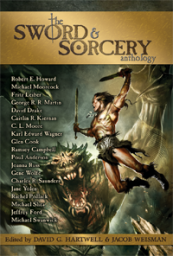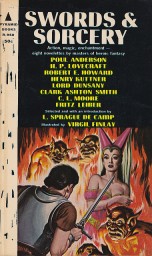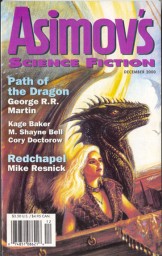The Sword & Sorcery Anthology
Sunday , 8, February 2015 Book Review, Fiction, Uncategorized 7 Comments A couple of years back, if you searched for Tachyon Publications’ The Secret History of Fantasy on Google Books, this is what would come up:
A couple of years back, if you searched for Tachyon Publications’ The Secret History of Fantasy on Google Books, this is what would come up:
“Tired of the same old fantasy? Here are nineteen much-needed antidotes to cliched tales of swords and sorcery. Fantasy is back, and it’s better than ever!”
The lure of filthy lucre must have proven to be too much as Tachyon published The Sword & Sorcery Anthology in 2012. You don’t see the above blurb anymore. The Sword & Sorcery Anthology is edited by David C. Hartwell and Jacob Weisman, trade paperback format, 480 pages, retails at $15.95.
Nineteen stories and an introduction by David Drake. I found it interesting that David Hartwell did not write a non-fiction piece for the book. He has written literally dozens of introductions and essays on science fiction. Hartwell had also co-edited nine volumes of Year’s Best Fantasy for Eos with Kathryn Cramer. Hartwell is perhaps unfamiliar with the details of sword and sorcery history.
Jacob Weisman is the series editor for several Tachyon anthologies. He has also been published in The Nation.
First, the cover. It is refreshing to see an actual painting instead of some lame photoshopped cover. The cover captures sword and sorcery. Jean-Sebastien Rossbach is listed as the cover artist. Good job!
I liked David Drake’s introduction entitled “Storytellers: A Guided Ramble into Sword and Sorcery Fiction” better on the second reading. He has some good lines contained therein:
“Comments have ranged from “Howard isn’t very good,’ through ‘One of Howard’s other series is much better than Conan,’ to ‘I’m responsible!’ claims– arrogant stupidity will always be with us…There have been Conan knockoffs and Conan pastiches (which are generally worse than the knockoffs) and Anti-Conans, but virtually all of the S&S which appeared after December 1932 was written in some degree with reference to Conan.”
Drake discusses the pulp era a little with Conan, Leigh Brackett’s Sword of Rhiannon, and C. L. Moore. He has a section devoted to the small press of the 1970s, which was a second golden age for sword and sorcery fiction. The silence is deafening as he does not discuss at all the post-1980 contents for this book.
There are nineteen stories. Here are the contents for this tome:
“The Tower of the Elephant” by Robert E. Howard
“Black God’s Kiss” by C. L. Moore
“The Unholy Grail” by Fritz Leiber
“The Tale of Hauk” by Poul Anderson
“The Caravan of Forgotten Dreams” by Michael Moorcock
“The Adventuress” by Joanna Russ
“Gimmile’s Song” by Charles R. Saunders
“Undertow” by Karl Edward Wagner
“The Stages of the God” by Ramsey Campbell (writing as Montgomery Comfort)
“The Barrow Troll” by David Drake
“Soldier of an Empire Unacquainted With Defeat” by Glen Cook
“Epistle From Lebanoi” by Michael Shea
“Become a Warrior” by Jane Yolen
“The Red Guild” by Rachel Pollack
“Six From Atlantis” by Gene Wolfe
“The Sea Troll’s Daughter” by Caitlín R. Kiernan
“The Coral Heart” by Jeffrey Ford
“Path of the Dragon” by George R. R. Martin
“The Year of the Three Monarchs” by Michael Swanwick
The stories range in original publication from 1933 to 2012. I thought it strange that seventeen stories are reprints while two are original to the book. I am a firm believer that anthologies should contain an internal theme and mixing reprints should be rarely done.
Nine stories (eleven if you include the Joanna Russ and Glen Cook stories) can be  considered to be canonical sword and sorcery. There is a reason for this. The classic sword and sorcery anthologies all appeared by 1980. L. Sprague de Camp edited four anthologies in the 60s and early 70s. Lin Carter edited The Young Magicians, New Worlds for Old, The Magic of Atlantis, and first six The Year’s Best Fantasy from D.A.W. Books. If a story was reprinted from a small press publication into book form, it became canon.
considered to be canonical sword and sorcery. There is a reason for this. The classic sword and sorcery anthologies all appeared by 1980. L. Sprague de Camp edited four anthologies in the 60s and early 70s. Lin Carter edited The Young Magicians, New Worlds for Old, The Magic of Atlantis, and first six The Year’s Best Fantasy from D.A.W. Books. If a story was reprinted from a small press publication into book form, it became canon.
So as a result, you have solid entries by foundational authors including Howard, Moore, Leiber, and Anderson. I found the reprint of the Michael Moorock story intriguing as that is one of the less reprinted Elric stories.
The 1970s entries are dependable. Karl Edward Wagner’s “Undertow” is one of the most memorable Kane stories. The Ramsey Campbell story has never been reprinted to my knowledge.
Some of the seven post 1980 stories get dodgy. There was sword and sorcery in the 1980s in Fantasy Book and Space & Time. The 1990s were lean and grim but still you had Shadow Sword and Adventures in Sword and Sorcery. The editors did no deep excavation.
I never thought of Jane Yolen as a sword and sorcery writer. I used to read her stories in The Magazine of Fantasy & Science Fiction decades back and liked them. Her story is good if not a bit clichéd. Does anyone find it disturbing there was an anthology entitled Warrior Princesses? That is where “Become a Warrior” originally appeared.
Two stories are from Marion Zimmer Bradley’s Sword and Sorceress anthologies. My view is Bradley’s anthology series quickly created a new category that can be called femizon fantasy that is distinct from sword and sorcery. The Charles Saunders story was a highlight of the original Sword and Sorceress and the highlight of the chronological later stories. Why was Rachel Pollack’s “The Red Guild” included (Sword and Sorceress #2)? You can stamp generic femizon story on this one.
I found it interesting that nothing was reprinted from Jessica Amanda Salmonson’s two Amazons! anthologies considering the effort to shoe horn femizon stories into the book. The Amazons! were better anthologies over Sword and Sorceress.
Gene Wolfe’s “Six From Altantis” (2006) is the closest you will ever see Wolfe doing Robert E. Howard. I like it but I don’t think everyone will.
“The Coral Heart” by Jeffrey Ford is a competently executed fantasy but lacks the over the top quality that characterizes classic sword and sorcery.
Michael Swanwick seems to be a darling of anthologers as I seem to run into him all the time lately. This is one of the original stories. It is only four pages long. On the surface, the story appears to be a Jack Vance imitation. Having read something else by him, it struck me. He fills the niche that Avram Davidson once held.
I am not going to complain that an original Nifft the Lean story by Michael Shea was included. Shea was the proverbial bastard child of Jack Vance though darker. He was taken from us too soon.
The big fly in the ointment in this book is “Caitlin” R. Kiernan’s “The Sea Troll’s Daughter.” I hated this story in Swords and Dark Magic (aka Swords & Scatology) and am aghast it was reprinted here. The story picks up after the action is over with our plucky swords woman who has killed a marauding sea troll. Most of the story is spent describing hangovers and lesbian action on the barmaid. Kiernan might be the second coming of H. P. Lovecraft with horror but keep away from sword and sorcery.
 Seven of the nineteen stories have female protagonists. By far the most famous is Daenerys Targaryen from A Song of Ice and Fire series. “The Path of the Dragon” is an excerpt from A Storm of Swords and appeared in Asimov’s Science Fiction magazine for the December 2000 issue. Martin had an excerpt from the first novel also in Asimov’s. I can’t blame the editors for including Martin, as it will probably drive sales. Martin is the 900 lb gorilla of fantasy whether we like it or not.
Seven of the nineteen stories have female protagonists. By far the most famous is Daenerys Targaryen from A Song of Ice and Fire series. “The Path of the Dragon” is an excerpt from A Storm of Swords and appeared in Asimov’s Science Fiction magazine for the December 2000 issue. Martin had an excerpt from the first novel also in Asimov’s. I can’t blame the editors for including Martin, as it will probably drive sales. Martin is the 900 lb gorilla of fantasy whether we like it or not.
I am still not quite sure what this anthology intended. If a chronological survey of the genre, there are too many holes. To put it in perspective, if I were to put together a book with stories by Jack Williamson, Edmond Hamilton, and Stanley Weinbaum from the 1930s, a Leigh Brackett story from the 1940s, Robert Silverberg and Randall Garett from the 1950s, a Harlan Ellison story from the 1960s, and then put in new stories by John Scalzi and Mary Robinette Kowal, it would have the same sort of imbalance.
But, this is the first reprint anthology including some sword and sorcery stories that I am aware of since Robert Adams’ two Barbarians! The book is available, reasonably priced and an introduction (if imperfect) to the genre.
What you said about “The Sea Troll’s Daughter” rings a bell. it sounds like a story about people talking about a story, not a framing device, but a way to avoid action, and especially alpha-male heroics, or even wise-woman wizardly showdowns. I haven’t read “Sea Troll’s Daughter” but it sounds like a lot of stuff I have read in “Amazon” S&S anthologies.
Compare this with “Black God’s Kiss.” Jirel doesn’t kill boatloads of demons with her mad sword skillz. She’s outclassed by the sheer weirdness and horror of the monsters. She’s a classic underdog protagonist. She triumphs by spiritual power. It’s an effective solution, Moore knew what she was doing. “Black God’s Kiss” is a story from a storyteller.
I’m not sure who could claim to be an heir of Moore these days. Saunders is with the Dossouye stories, which mix up some good sword-swinging action with what you might call a spiritual showdown (in the Moore style). There’s always a story in his stories.
Janrae Frank was pretty decent though I’m not sure if she’s still writing. Dunno who else there is these days.
Dear Morgan,
A few points.
The “I, not Robert E Howard…,” quote was Dennie O’Neill of Marvel Comics. Without going into the question of what Sprague believed, he was far too much of a gentleman to have made that statement.
Jacob Weissman called me on a Tuesday, asking if I could do an intro for the volume in a week. (I turned it in that Friday.) Jacob had tried three times himself, but his managing editor told him he needed to get someone else. (I don’t know Jacob more than to have nodded to him in a dealer’s room maybe a dozen times in my life. I’m still not sure why he asked me for the intro.)
I got the strong impression from Jacob’s conversation that David Hartwell’s contribution was limited to putting his name on the cover. He had intended to do the intro but had been unable to do so.
Jacob had found _The Barrow Troll_ in an anthology. I recommended the particular story of Karl’s and also Ramsey’s. Stu Schiff, Ramsey and I may have been the only people alive who knew who Mongomery Comfort was. That was the extent of my contribution to the editing.
Incidentally, Jacob believes he paid me for the intro; that may be true, but I have no record of it. In any case, it was purely a labor of love for me.
All best
Dave
I think S&S should be tough, action oriented and masculin. But the protagonist can be female and still be all of the above. Women can be stone cold killers too. What I don’t want to read is dialog exchanges about feelings, angst and teenage broken hearts. Hell, I long for the days of cookie-cutter Northern barbarian Clonan paperbacks-at least they were more entertaining than most of this p.c. dreck. I can’t find any new, old time S&S, so I think I will write some of my own…
Just an aside, Lin Carter did edit the Flashing Swords series. Which I enjoyed at least the first three.
I have this anthology, and based on the review, will give it a read.